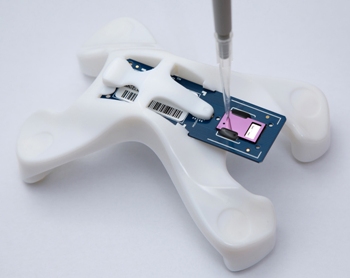Veredus Laboratories today announced that the current version of VereFlu detects the current subtype of H7N9 (Avian Flu) that is responsible for the Flu outbreak in China. H7N9 is the latest mutation to cause concern and increased surveillance in the region.
 VereFlu Lab on Chip
VereFlu Lab on Chip
Launched in 2008 and built on the STMicroelectronics lab-on-chip platform, VereFlu run on Veredus' VerePLEX™ biosystem is the market's first test to integrate two powerful molecular biological applications, Polymerase Chain Reaction (PCR) and a microarray, onto a Lab-on-Chip platform.
VereFlu is a portable lab-on-chip application for rapid detection of all major influenza types at the point of need. Unlike existing diagnostic methods, VereFlu is a breakthrough molecular diagnostic test that can detect infection with high accuracy and sensitivity, within two hours, providing genetic information on the infection that traditionally could take days to weeks to learn. With its high level of automation, users outside the traditional lab environment can easily perform the tests at the point of need. In addition to the current H7N9 Avian Flu, VereFlu is proven to identify and differentiate human subtypes of Influenza A (H1, H3, H5, H7, H9) and B viruses, including the Avian Flu subtype H5N1, and the 2009 pandemic H1N1/2009, all in a single test.
"After learning of the outbreak in China, we have confirmed in-silico[1] that our current VereFlu influenza panel is able to detect the subtype of H7N9 responsible for this outbreak in addition to other human Flu A and B infections," said Rosemary Tan, chief executive officer of Veredus. "This confirms our vision when we designed the panel for the need to have a multiplexed molecular test to detect not only the typical seasonal influenza subtypes but also novel emerging subtypes, including the current H7N9 subtype, capable of making the jump from animals to humans. Our customers can be assured that with VereFlu they are able to detect H7N9 and we are able to deliver immediately a fast, reliable surveillance system that can be deployed to help monitor the current situation."
[1] in simulations based on known DNA sequences of H7N9